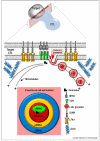The synapse and cytolytic machinery of cytotoxic T cells
- PMID: 20226643
- PMCID: PMC4101800
- DOI: 10.1016/j.coi.2010.02.008
The synapse and cytolytic machinery of cytotoxic T cells
Abstract
Cytotoxic T lymphocytes (CTLs) rapidly kill target cells via the release of lytic granules into the immunological synapse, a process directed by the docking of the centrosome at the plasma membrane. New evidence highlights how signal strength and avidity influence the recruitment of cytolytic machinery to the synapse, and the role of each synaptic compartment. Release of cytolytic effector proteins, including perforin and FasL, is controlled at multiple levels and is also influenced by the avidity of the interaction. New imaging technologies and the use of photoactivatable peptides have allowed the dissection of signalling molecules involved in each step of the cytolytic process. This review highlights the important role of avidity in controlling how a T cell kills its target.
Copyright 2010 Elsevier Ltd. All rights reserved.
Figures


References
-
- Stinchcombe JC, Bossi G, Booth S, Griffiths GM. The immunological synapse of CTL contains a secretory domain and membrane bridges. Immunity. 2001;15:751–761. - PubMed
-
- Monks CR, Freiberg BA, Kupfer H, Sciaky N, Kupfer A. Three-dimensional segregation of supramolecular activation clusters in T cells. Nature. 1998;395:82–86. - PubMed
Publication types
MeSH terms
Grants and funding
LinkOut - more resources
Full Text Sources

